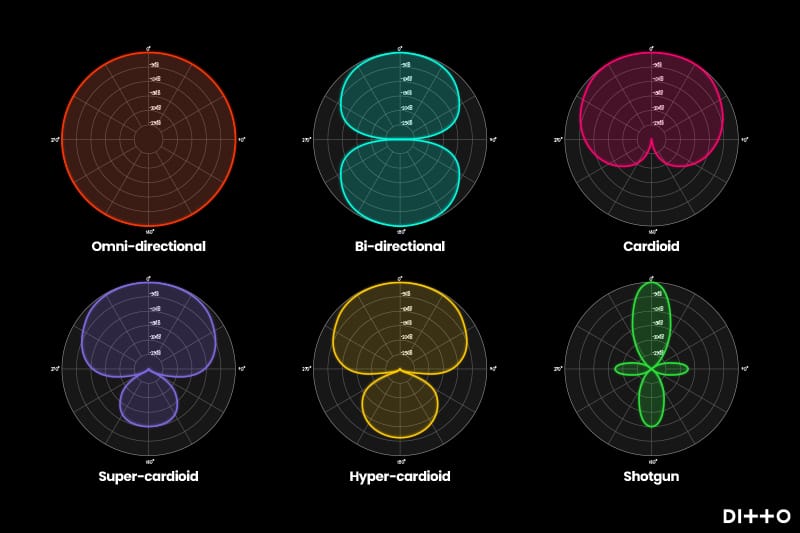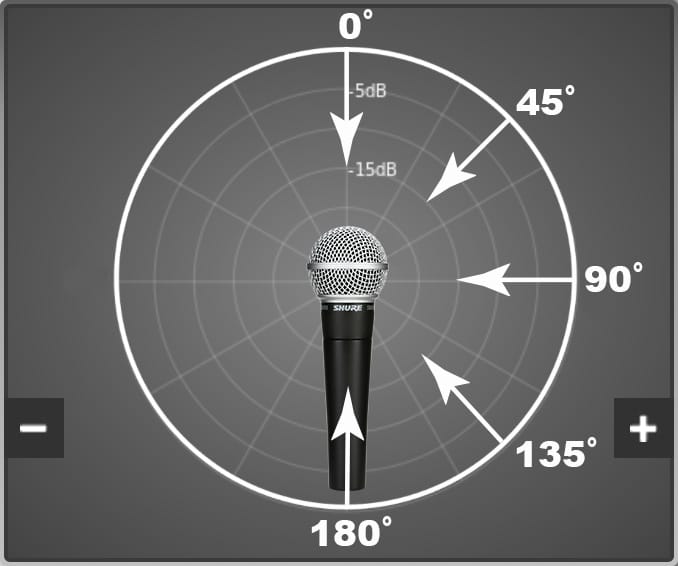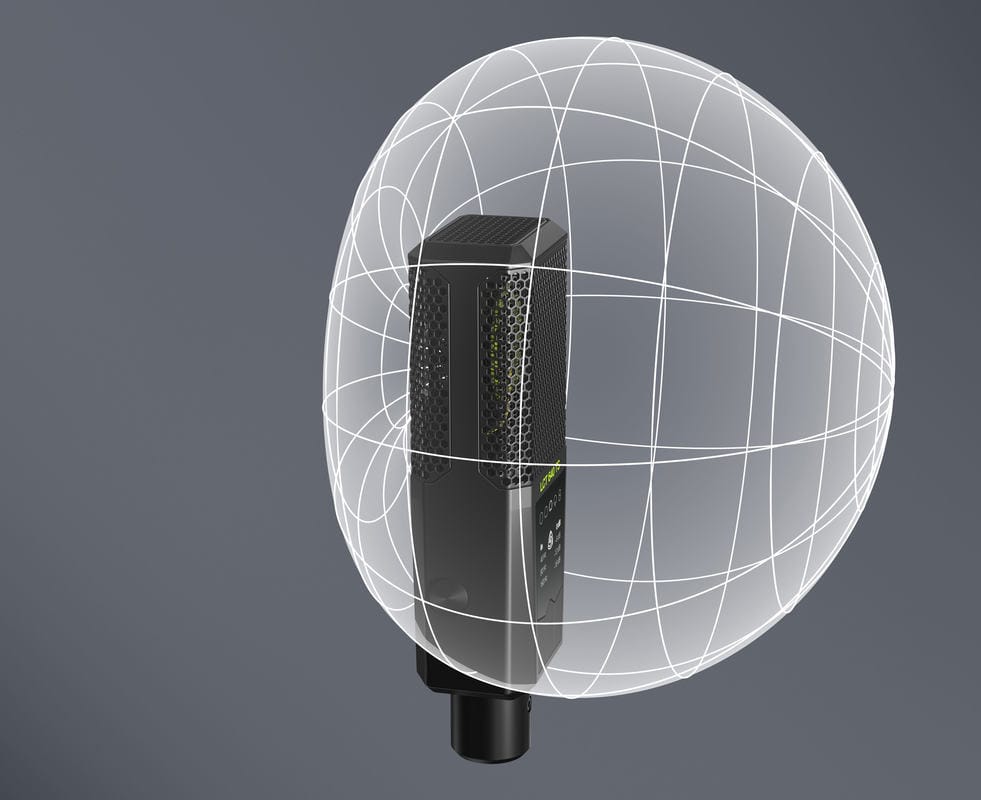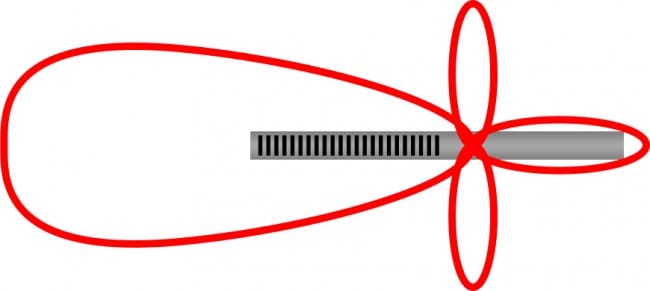The science and technical terms behind different microphone designs

Microphones come in a variety of shapes and sizes, but there's more to the design than looks. Various types, or polar patterns, collect sound from different directions and at varying levels of sensitivity. If you already know the specs on a dynamic hypercardioid and a bi-directional condenser, great! If not, we've broken it all down. Read on!

Knowing the polar pattern of your microphone can greatly enhance recording efficiency.
Omnidirectional:

Speak into the top or the sides; an omni microphone gathers sound from every angle.
Characteristics: Omnidirectional microphones capture sound with equal sensitivity from all directions. This means that regardless of the direction from which the sound originates, the microphone will pick it up without bias. This pattern is represented by a perfect circle in polar pattern diagrams.
Applications: Ideal for situations where sound is coming from multiple directions and a natural ambiance is desired. These microphones are commonly used in field recordings, conference settings, and situations where the microphone movement is unrestricted or unpredictable. They are also favored for capturing environmental sounds or group discussions.
Bidirectional:

For one-on-one conversations or capturing sounds from opposite directions, the bi-directional will filter noise from the sides but emphasize a single plane.
Characteristics: Also known as figure-8 microphones, these capture sound equally from the front and back but reject sounds from the sides. This pattern is characterized by its figure-8 shape in polar diagrams.
Applications: Bidirectional microphones are particularly useful in stereo recording techniques such as mid-side (MS) recording. They are also suitable for recording two sources facing each other, like a duet or an interview setting where the interviewer and interviewee are on opposite sides.
Cardioid

Hear me, hear me; Cardioid mics focus on a single speaker, minimizing sounds coming from any other angle.
Cardioid microphones, which are shaped like a heart, are designed to capture sound from the front and sides while rejecting noise from the back. This feature is particularly beneficial when recording a podcast with two people. By positioning cardioid mics 180 degrees from each other, you can minimize crosstalk and audio bleed from your co-host. Our desktop mics, the SM7dB from Shure, are this type. It's the cover picture on this article.
Characteristics: The cardioid pattern, resembling the shape of a heart, primarily picks up sound from the front and sides with less sensitivity at the back. This directional pattern offers significant rejection of sound coming from behind the microphone, which is especially useful in controlling unwanted background noise.
Applications: Cardioid microphones are the most versatile and commonly used pattern in both studio and live settings. They are excellent for podcasts, vocals, and instrument recordings where isolating the subject from background noise is crucial. They also work well in live performances to avoid feedback from speakers.
Hypercardioid:
Characteristics: Similar to the cardioid pattern but with an even tighter area of front sensitivity and a smaller lobe of sensitivity to the rear. Hypercardioid microphones offer better isolation and side rejection than cardioids, which makes them suitable for noisy environments.
Applications: These microphones are typically used in live sound environments and for recording in untreated acoustic spaces where background noise is a concern. They are also ideal for miking loud instruments such as drums or for use in film and television where directional audio capture is needed.
Supercardioid:
Characteristics: Supercardioid microphones have a pickup pattern that’s a compromise between cardioid and hypercardioid, with a slightly wider front pickup angle but more rear pickup than hypercardioids. They offer a good balance of front sensitivity and rear rejection.
Applications: Useful in live sound situations where tighter control over the pickup pattern is necessary but some rear pickup is acceptable. They are also great for use on stage to capture the performer’s voice while reducing audience noise.
Lobar (Shotgun):

Shotgun microphones, known for their high directionality, are a staple in environments where capturing clear audio from a distance is crucial. These microphones are distinguishable by their elongated design, resembling a shotgun barrel. We use Shure's VP82 shotguns in several of our studios.
Contrary to popular belief, shotgun microphones do not "reach out" to capture distant sounds. Instead, they are designed to reject off-axis sounds. This makes them ideal for capturing specific sounds like a distant conversation or wildlife noises in nature documentaries.
Characteristics: Shotgun mics feature an interference tube, which sits in front of the microphone capsule. This tube, dotted with openings along its length, manipulates the way sound waves reach the microphone. Sounds arriving directly in front (on-axis) are captured clearly because they travel uniformly to the capsule. However, sounds coming from other directions (off-axis) enter the tube at different points, traveling varied distances and arriving at different times. This misalignment causes the sounds to be out of phase with each other, leading to cancellation of these unwanted noises.
Applications: Different lengths of shotgun microphones cater to various recording scenarios. Long shotguns are preferred in loud environments or when capturing very distant sounds, while medium-length microphones are versatile for general use. Shorter models are useful where space is limited or in less demanding acoustic environments.
Each polar pattern offers distinct advantages and can be selected based on the specific requirements of the recording environment and the source material.
Condenser vs Dynamic
Dynamic microphones are the preferred choice for most podcasters, especially those recording from home or various non-studio environments. They are ideal because they effectively capture sound close to the microphone while rejecting background noise, making them versatile for live performances, outdoor reporting, and other settings outside a soundproof studio.
Condenser microphones, while offering higher sound quality and sensitivity, are best suited for controlled studio environments. They can pick up a wide range of frequencies and deliver clear, crisp audio, but are prone to capturing background noise and reflections in less ideal environments. This sensitivity can also lead to feedback and other noise issues when using multiple condenser mics in the same room.
For podcasters, dynamic microphones are a more practical option. They are cheaper, durable, and less sensitive to background noise. Although they might produce a slightly duller sound compared to condenser mics, this can often be remedied with basic audio processing techniques like EQ and compression.
Unless you have access to a soundproof recording booth, the practical, versatile choice for podcasting is a dynamic microphone. Condenser microphones, despite their superior sound quality, are generally not recommended for podcasters due to their sensitivity to environmental noise and reflections.
Headphones: Your Microphone's Best Friend
Using headphones during recording sessions is vital for real-time audio monitoring. This setup enables you to hear immediately if you move out of the microphone's optimal range, as your voice will become quieter. This instant feedback allows you to adjust your position to maintain consistent audio levels, ensuring clear and professional sound quality.
Incorporating these microphone techniques will not only improve the sound quality of your podcast but also provide a more professional listening experience. Being knowledgeable about your equipment and how to effectively use it are key components that can set your podcast apart in a crowded and growing field.